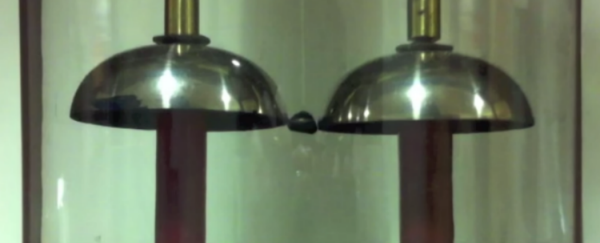
On a shelf in the foyer of the Clarendon Laboratory of Oxford University in the UK sits the most economical electric bell in the world. Known officially as the Clarendon Dry Pile, this little contraption has been ringing its two brass bells almost continuously since at least 1840, save for a few hiccups due to high humidity and a couple of relocations.
Records show the humble bell was first purchased in London by Oxford physics professor Robert Walker and "set up in 1840", but there's also evidence to suggest that it was actually put to work 15 years earlier than that. Either way, this thing has lasted a ridiculously long time, and Walker sure did get his money's worth. According to Jason Koebler at Motherboard, it's rung roughly 10 billion times so far, which isn't as insanity-provoking as you might think - it's practically inaudible now, so you have to look really close to see that it is indeed still working.
It works using one of the first types of electric batteries ever invented - the dry pile. The idea is that its two brass bells are each positioned beneath one of these dry pile batteries, and a tiny metal sphere - or 'clapper' - is suspended between the two bells. This 4-millimetre clapper vibrates between the bells and rings them due to an electrostatic force, maintained by the ringing of the bells. So, when the clapper hits one bell, it's charged by the corresponding dry pile, and electrostatically repelled. This pushes the clapper into the other bell, where it's charged by that bell's corresponding dry pile, repelled into the other bell, rinse and repeat. Over and over and over again.
The system is so efficient because only a tiny amount of charge is carried between the bells - about 1 nanoAmp each time the clapper vibrates between the bells, says Koebler at Motherboard.
Writing about it in 1984, AJ Croft, then a researcher at Oxford's Clarendon Laboratory, explains the mystery behind the little bell's power in The European Journal of Physics:
"What the piles are made of is not known with certainty, but it is clear that the outer coating is of sulphur, and this seals in the cells and the electrolyte. Piles similar to this were made by [19th century dry pile researcher Giuseppe] Zamboni, whose batteries were constituted of about 2,000 pairs of discs of tin foil glued to paper impregnated with zinc sulphate and coated on the other side with manganese dioxide. The piles, of course, are not dry, but contain the right amount of water to provide the electrolyte without causing a short-circuit."
The team at Oxford will eagerly pull apart these dry piles once they finally die to see what they're made of, but right now, all they've got to go on is an educated guess. What we do know is that pretty much every battery we're using right now should be very ashamed of itself.
Source: Motherboard
